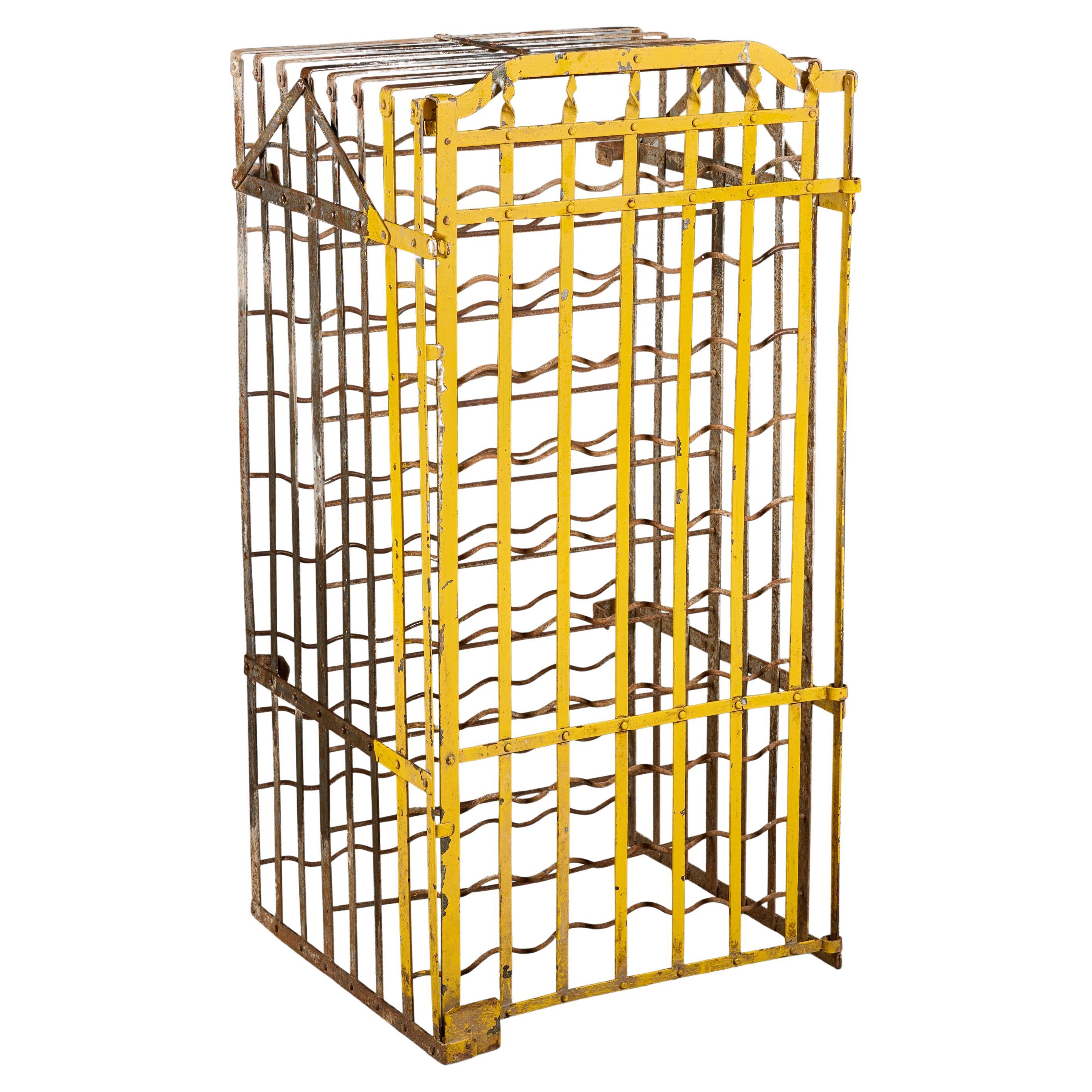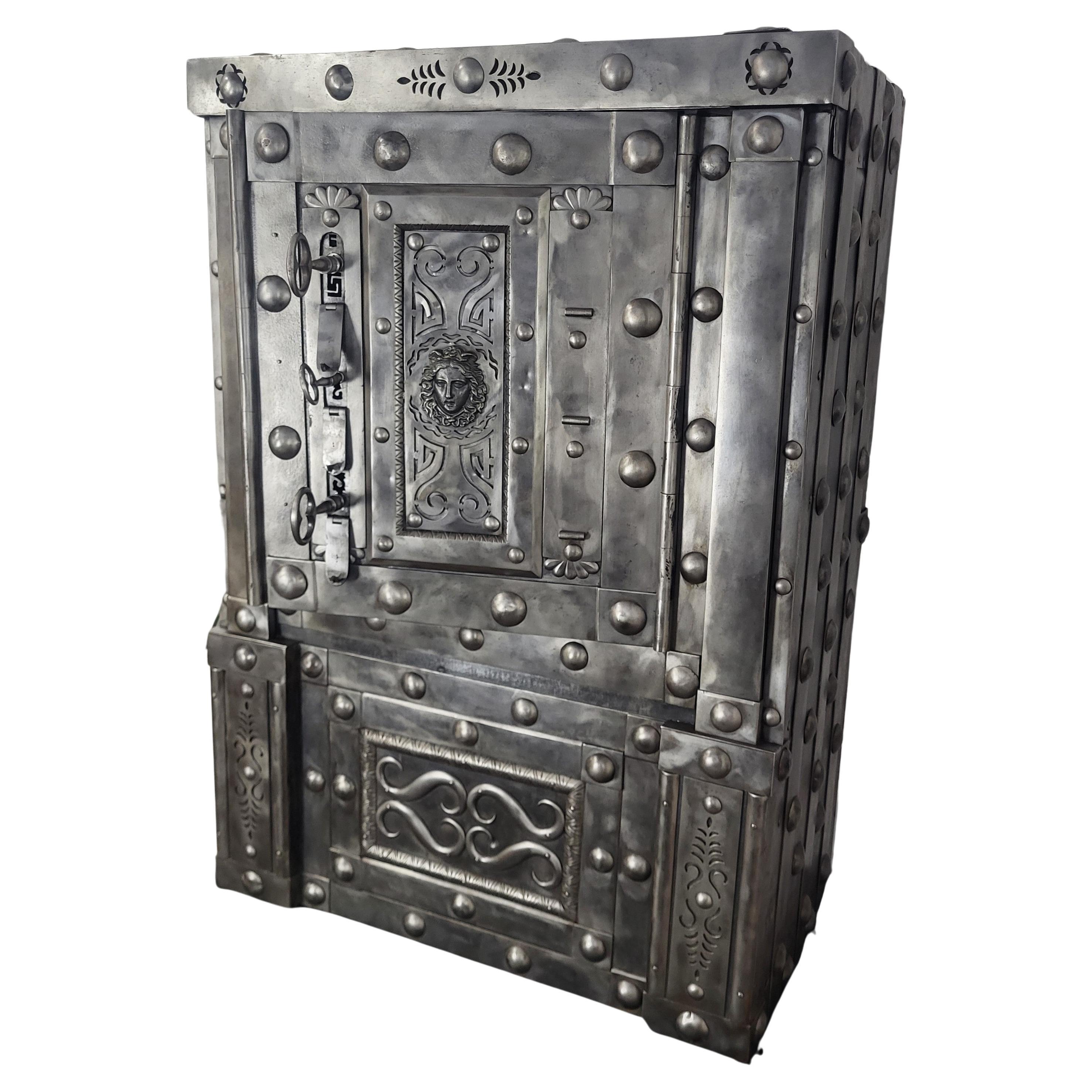Items Similar to Italian Baroque Iron Safe
Want more images or videos?
Request additional images or videos from the seller
1 of 9
Italian Baroque Iron Safe
About the Item
Visually imposing and mechanically complex, this formidable Italian Baroque safe would have provided unparalleled security for storing valuables in the 18th century. The hobnail motifs covering the safe are a testament to the fine artistry and craftsmanship of Piedmont metalworkers of this time.
Beautifully restored and fully functional, this iron safe utilizes hidden keyholes and a 3-key locking mechanism meant to confuse and thwart its users. The three keys are stored in a beautifully fitted blue velvet-lined drawer, and they are all unique and must be used precisely and in a particular order, in concert with a special pick, to gain access to the safe’s interior. Once inside, the lit interior of the safe features a magnificent wooden jewelry case that sits on a raised shelf above another locked compartment, for storing the owner’s most precious of valuables. Given its fine craftsmanship and pristine condition, it is one of the few exceptional floor safes of this size and complexity that can be found today.
Circa 1700
36 3/4” wide x 23 3/8“ deep x 63 3/8“ high
- Dimensions:Height: 63.38 in (160.99 cm)Width: 36.75 in (93.35 cm)Depth: 23.38 in (59.39 cm)
- Style:Baroque (In the Style Of)
- Materials and Techniques:
- Place of Origin:
- Period:
- Date of Manufacture:Circa 1700
- Condition:
- Seller Location:New Orleans, LA
- Reference Number:
About the Seller
5.0
Recognized Seller
These prestigious sellers are industry leaders and represent the highest echelon for item quality and design.
Established in 1912
1stDibs seller since 2010
93 sales on 1stDibs
Typical response time: 7 hours
- ShippingRetrieving quote...Ships From: New Orleans, LA
- Return PolicyThis item cannot be returned.
More From This SellerView All
- Italian Rococo-Style Giltwood VitrinesLocated in New Orleans, LAThis extraordinary pair of Rococo-style vitrines is an exceptional example of Italian cabinetry. Beautifully designed and executed in giltwood, the stunning pair is set apart by a pr...Category
Antique 19th Century Italian Rococo Vitrines
MaterialsGiltwood
- Flemish Baroque Tortoiseshell MirroBy FlemishLocated in New Orleans, LAThis monumental 17th-century Flemish mirror is crafted in the grand Baroque style. The magnificent frame is veneered in exquisite tortoiseshell with wave-moulded bands of ebony providing a flawless accent. Tortoiseshell and ebony were both among the most precious and coveted materials of the 17th century, and are used to their utmost effect in this exceptionally rare looking glass. Flemish glassworkers enjoyed a reputation of excellence beginning in the 16th century. These skillful craftsmen are credited with the invention of the tin-mercury method of mirror-making, a process that made polished metal mirrors obsolete. They employed and excelled in a number of decorative techniques in creating the frames, including marquetry, japanning (Dutch and Flemish japanning was of the highest quality, surpassing even the English), and the use of tortoiseshell veneering...Category
Antique 17th Century Baroque Wall Mirrors
MaterialsMirror, Ebony, Tortoise Shell
- 19th Century Watch Winding Display CabinetLocated in New Orleans, LAThis incredible, one-of-a-kind watch display cabinet brings together the beauty of an antique with the functionality of modern technology. Crafted of mahogany, this 19th century jewelry display cabinet...Category
Antique 19th Century Unknown Empire Cabinets
MaterialsMahogany
- King George I Ambassadorial Secrétaire-CabinetLocated in New Orleans, LAThis highly important secrétaire-cabinet was crafted for and specially ordered by King George I for the British Ambassador to Russia. From its craftsmanship and materials to its exceptional artistry, it is a work of royal and historic significance that exudes power in each and every detail. The broken pediment at its apex features the simplified royal coat of arms bearing the king’s crown, while the interior is adorned by portraits of the British Royal Family. Placed within the ambassador’s St. Petersburg home, this entirely unique piece of furniture would have been a potent reminder of England's grandeur and political importance. Relations between England and Russia during this period were at an all-time high. Peter the Great had traveled to England in 1698 as part of his widely known “Grand Embassy” tour, wherein he attempted to gain foreign support against the Ottoman Empire. He spent a period of nearly four months there, meeting with King William III and his court on numerous occasions. Noted academic Arthur MacGregor wrote concerning the impact of the trip, “For two decades following Peter's visit, British influence in Russia reached a peak. It manifested itself in social custom, in craft practice and in ships and naval organization... it reached a significant sector of the population before relations cooled once again and the two nations pulled back from this era of unprecedented cordiality.” First and foremost, however, it is a reminder of British might and influence. By the reign of King George I, England had come into its own as a world power. Unique in its design, this cabinet is a reflection of the country’s might. It is crafted from the highest-quality solid walnut and burr walnut adorned by gilded lock plates and engraved hinges. The presence of ormolu at its apex and lining the doors was a rarity for this period, and its addition makes manifest the importance of the design. The outer doors open to reveal multiple interiors, including fifteen separate drawers around a central cupboard; the cupboard doors each bear mezzotint portraits of George I and his father, Ernest Augustus, Elector of Hanover. An etching after the portrait of George I dating to circa 1716 is in London’s Royal Academy. A second, inner pair of doors are adorned by mezzotints of the Prince and Princess of Wales (later Queen Caroline and George II), which are both after portraits by Sir Godfrey Kneller dated 1716 in the Royal Collection. A final portrait is revealed on the very interior of the cabinet, where a mezzotint of Frederick, Anne, Amelia and Caroline, children of the Prince of Wales, resides. An etching (circa 1715-1720) after this portrait can be found in the National Portrait Gallery (London). Apart from its abundance of royal portraiture, the cabinet features stunning painted decoration, including floral designs as well as clouds, birds and trees in a bucolic motif reminiscent of Eden. Its lower portion is a study in both form and function, featuring a fitted secrétaire-drawer above three additional drawers for storage. The cabinet appears in The Shorter Dictionary of English Furniture by R. Edwards from 1964, a text that is regarded as the bible of British furniture design. Edwards describes it as a “writing cabinet...given by George I to the British Ambassador at the Russian court.” The cabinet was likely made for the 18th-century German diplomat and writer Friedrich Christian Weber, who represented English interests at the Russian court from 1714 until 1719. Although Weber’s tenure as ambassador was relatively short, while in St. Petersburg, he authored his account entitled Das veraenderte Russland (The Present State of Russia), which was published in three volumes in 1721, 1739 and 1740. It may, however, also have been made for George Douglas, 2nd Earl of Dumbarton, who served as ambassador alongside Weber in 1716. Diplomatic relations ceased between the two countries in 1721. In 1928, the cabinet appeared for sale at the International Exhibition of Antiques & Works of Art in Olympia. It had previously been in the collection of the Woltner family of Bordeaux, the celebrated vintners who owned the estate Château Laville Haut-Brion and produced wine of the same name. According to the family, Monsieur Woltner was given the cabinet as a gift from an aunt who lived in Russia for many years. After leaving the Woltner collection, the cabinet was acquired by William Berry...Category
Antique 18th Century English Georgian Secretaires
MaterialsBrass
- 19th Century French Secrétaire by DurandBy Gervais DurandLocated in New Orleans, LASuperior craftsmanship and intricate marquetry characterize this rare secrétaire by Gervais-Maximilien-Eugène Durand, one of the most popular French ébénistes of the 19th century. Th...Category
Antique 19th Century French Louis XV Secretaires
MaterialsBronze, Ormolu
- Mahogany Upright Cane CabinetLocated in New Orleans, LAClassical style and impeccable design distinguish this English upright cane cabinet. Crafted of lustrous Cuban mahogany, this case is comprised of a beautifully paneled door which op...Category
Antique 19th Century English Cabinets
MaterialsBrass
You May Also Like
- Wrought Iron Wine SafeLocated in Chicago, ILWrought iron multi bottle wine safe. Hangs on wall or sits on floor.Category
Vintage 1930s Argentine Cabinets
MaterialsWrought Iron
- Wrought Iron Wine SafeLocated in Chicago, ILWrought iron multi bottle wine safe. Hangs on wall or sits on floor.Category
Vintage 1930s Argentine Cupboards
MaterialsWrought Iron
- Wrought Iron Wine SafeLocated in Chicago, ILWrought iron multi bottle wine safe. For wall or floor.Category
Vintage 1930s Argentine Dry Bars
MaterialsWrought Iron
- 18th Century Wrought Iron Italian Hobnail Antique Safe Strong Box CabinetLocated in Carimate, ComoBeautiful and rare example of late 18th century Italian master blacksmith craftsmanship, this antique studded safe with typical all-around hobnails and great wrought iron details, is...Category
Antique Late 18th Century Italian Baroque Cabinets
MaterialsMetal, Wrought Iron
- 18th Century Wrought Iron Italian Antique Hobnail Safe Strong Box Bar CabinetLocated in Carimate, ComoBeautiful and rare example of late 18th century Italian master blacksmith craftsmanship, this antique studded safe with typical all-around hobnails and great wrought iron details, is...Category
Antique Late 18th Century Italian Baroque Cabinets
MaterialsMetal, Wrought Iron
- Italian 17th Century Baroque Period Walnut and Iron Specimen CabinetLocated in West Palm Beach, FLA handsome Italian 17th century Baroque period Walnut and iron specimen cabinet. The three door eleven drawer cabinet is raised by impressive paw feet below a mottled border with a striking reeded gadroon like design. At the center are two doors decorated with arch shaped recessed panels with fine foliate carvings and iron lion head pulls flanked by remarkable columns with large acanthus leaves and richly carved personages. The two drawers also display handsome lion head iron...Category
Antique 17th Century Italian Baroque Cabinets
MaterialsIron
Recently Viewed
View AllMore Ways To Browse
Hidden Jewelry Cabinet With A Lock
Brazilian Shelving
Antique Veneer Glass China Cabinet
Mulberry Drawers
Pennsylvania House Display Cabinet
John Austin Sheet Music Cabinet
Wave Pelmet
Stained Glass Industrial
Trompe L Oeil Cabinet
Small Antique Italian Mirrored Cabinets
Cherub Door
Small Shelf Mirror
Pair Industrial Cabinets
Tall Interior Doors
Over The Door Pediments
Set Of Doors Mid Century
Guillerme Et Chambron Bouvine
Index Card Filing Box





